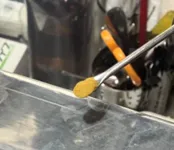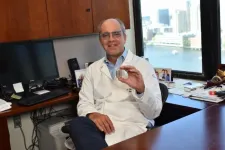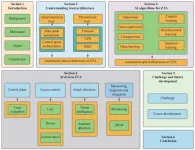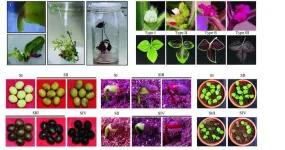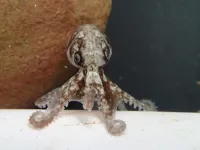Robotically assisted lung transplants are on the horizon
2024-04-11
(Press-News.org)
Embargoed until 8:30 am Thursday, 11 April, 2024 Central European Summer Time (GMT +2)
11 April, 2024, Prague, Czech Republic—While debating the pros and cons of robotically assisted lung transplantation, Albert Jauregui, MD, PhD told attendees at the Annual Meeting and Scientific Sessions of the International Society for Heart and Lung Transplantation (ISHLT), today in Prague that the time for robotic surgery is now.
Although robots are commonly used to assist in surgery, robotically assisted surgery is not routinely used for lung transplants. Approximately 4,600 lung transplants are performed annually around the world.
“We’ve been doing robotically assisted, minimally invasive surgeries for lung cancer for the last several years,” said Dr. Jauregui, chief of the Thoracic Surgery and Lung Transplant Department, Vall d'Hebron University Hospital in Barcelona, Spain. “Lung cancer patients are already benefiting from robotic platforms to make their surgery less invasive, but patients who need a lung transplant are still being offered an aggressive surgery. For our team, it didn't make any sense. We felt like things had to start changing.”
In February 2023, Dr. Jauregui’s team performed Spain’s first robotically assisted single-lung transplant; three months later they performed a second single-lung transplant. Both patients showed good improvement in the postoperative period and needed only mild medication for the pain caused by the surgery.
“We accomplished our main objective for this minimally invasive approach, which was to reduce the size of the surgical incision and the need for powerful pain drugs that interfere with wound healing,” said Dr. Jauregui. “We are happy with the outcome of the first lung transplant patients with robotic surgery, but we have to continue working to be able to offer this type of surgery to more patients.”
Dr. Jauregui’s team spent hours in the lab performing robotically assisted surgeries with synthetic lungs before moving to large animal models. By deflating the lung and relying on the skin’s flexibility, surgeons discovered they could use a smaller incision below the sternum to remove and insert the lungs.
“Lung transplants are a very tough procedure, from donor selection through the surgery to the postoperative period,” said Dr. Jauregui. “Unlike other organs that are all protected inside the body, the lungs are connected to the environment through breathing. It’s one of the most difficult organs to transplant.”
After the two successful robotically assisted lung transplants, Dr. Jauregui’s team began working with a medical device company to develop design robotic instruments specifically for lung transplantation.
“Our next goal is to perform a bilateral lung transplant,” he said. “We plan to perform five robotically assisted procedures this year and 10 next year.”
Another objective for Dr. Jauregui’s department is to disseminate the new technique to more lung transplant programs.
“We believe that reducing surgical aggression is better for patients, however, we need a greater number of procedures to confirm our theory,” he said.
Co-presenter Konrad Hoetzenecker, MD, PhD, director of the Vienna Lung Transplant Program in Austria, acknowledged that “keeping the incisions as small as possible has reduced surgical trauma in lung cancer patients, attempting to do the same with lung transplants sounds at first sight reasonable.”
“However, the technique of robotic lung transplantation is premature, and it is questionable whether a robotic platform will ever be suitable to support lung transplantation,” he said. “Unlike other thoracic procedures, surgical time is an essential factor for the functionality of the implanted donor organ. Utilizing a robot in lung transplantation means longer operation times and this poses a significant threat to graft function and the survival of a patient.”
Dr. Hoetzenecker underlined that robotic platforms need significant further development before they could eventually become an option for lung transplantation.
END
About ISHLT
The International Society for Heart and Lung Transplantation (ISHLT) is a not-for-profit, multidisciplinary, professional organization dedicated to improving the care of patients with advanced heart or lung disease through transplantation, mechanical support, and innovative therapies via research, education, and advocacy. ISHLT members focus on transplantation and a range of interventions and therapies related to advanced heart and lung disease.
The ISHLT Annual Meeting and Scientific Sessions will be held 10-13 April at the Prague Congress Centre in Prague, Czech Republic.
CONTACT:
Jess Burke, CAE
ISHLT Director of Marketing and Communications
+1.312.224.0015
END
ELSE PRESS RELEASES FROM THIS DATE:
2024-04-11
The full power of next-generation quantum computing could soon be harnessed by millions of individuals and companies, thanks to a breakthrough by scientists at Oxford University Physics guaranteeing security and privacy. This advance promises to unlock the transformative potential of cloud-based quantum computing and is detailed in a new study published in the influential U.S. scientific journal Physical Review Letters.
Quantum computing is developing rapidly, paving the way for new applications which could transform services in many ...
2024-04-11
The pursuit of greener energy also requires efficient rechargeable batteries to store that energy. While lithium-ion batteries are currently the most widely used, all-solid-state sodium batteries are attracting attention as sodium is far more plentiful than lithium. This should make sodium batteries less expensive, and solid-state batteries are thought to be safer, but processing issues mean mass production has been difficult.
Osaka Metropolitan University Associate Professor Atsushi Sakuda and Professor Akitoshi Hayashi, both of the Graduate School of Engineering, led a research team in developing ...
2024-04-11
While Obstructive Sleep Apnea (OSA) affects about five percent of the general pediatric population, 80 percent of children with Down syndrome experience OSA. Continual OSA results in poor health, including disruptions to cognitive development and functioning, leading physician-researchers from Mass General Brigham to investigate better methods to treat these patients as early as possible to maximize their health outcomes.
In a new case study published April 11 in Pediatrics, they report on a 4-year-old boy with Down syndrome and OSA who underwent a procedure to implant a hypoglossal nerve stimulation device, and experienced improvements thereafter. ...
2024-04-11
Arlington, Va. — April 11, 2024 — A new study published today in the American Journal of Infection Control (AJIC) reports the infection prevention steps taken to control a months-long multispecies outbreak of carbapenemase-producing Enterobacterales that occurred in a pediatric ward at the Toho University Omori Medical Center in Tokyo in 2017. This study highlights the particular vulnerability for contamination through sinks and other water sources; indeed, even replacing all sinks in the ward did not stop this outbreak.
Carbapenemase-producing Enterobacterales (CPE) are a major public health threat ...
2024-04-11
COLUMBUS, Ohio – Although lung cancer is traditionally thought of as a “smoker’s disease,” a surprising 15-20% of newly diagnosed lung cancers occur in people who have never smoked, many of whom are in their 40s or 50s.
Doctors say this concerning rise in non-smoking lung cancer cases is likely linked to long-term, high exposures of radon gas. This colorless, odorless gas is emitted from the breakdown of radioactive material naturally occurring underground that then seeps through building foundations. The gas can linger and ...
2024-04-11
With the increasing environmental and resource problems associated with agriculture, the promotion of sustainable agricultural development has been recommended in many areas of China and also beyond its borders. As a contribution to achieving sustainable development goals, the Chinese government first proposed green development in 2015 and implemented the agriculture green development (AGD) program in 2017 to address a range of issues related to the future development of agriculture in China and the well-being ...
2024-04-11
To date, most network security architectures have used perimeter-based defense to isolate internal networks from external networks. Firewalls, virtual private networks (VPN), and demilitarized zone (DMZ) networks prevent external attacks by creating a network security perimeter. This can effectively prevent external attacks, but it is difficult to prevent internal attacks because once an intruder breaches the security perimeter, further illegal actions will not be hindered. In addition, with the rapid development of digital technologies such as 5G, the ...
2024-04-11
This study is led by Professor Wensheng Hou (Institute of Crop Sciences, Chinese Academy of Agricultural Sciences, Beijing, China). The authors engineered a novel expression vector designed to facilitate gene editing and enable visual confirmation of successful modifications. To achieve this, the authors used RUBY reporter which harnessed the ability to convert tyrosine into a vivid red betalain pigment. This breakthrough allowed to visually confirm gene expression in soybean plants without the need for specialized equipment.
By utilizing this innovative color-based screening system, the authors could quickly assess whether genetic modifications ...
2024-04-11
New evidence of one of the first cities in the Pacific shows they were established much earlier than previously thought, according to new research from The Australian National University (ANU).
The study used aerial laser scanning to map archaeological sites on the island of Tongatapu in Tonga.
Lead author, PhD scholar Phillip Parton, said the new timeline also indicates that urbanisation in the Pacific was an indigenous innovation that developed before Western influence.
“Earth structures were being constructed in Tongatapu around AD 300. This is 700 years earlier than previously thought,” ...
2024-04-11
Octopuses have been around for hundreds of millions of years, but did you know that most only live for a few years, dying soon after mating or laying eggs?
Until now that hasn’t been a problem, but octopus catches have doubled in recent decades as the world strives to meet the nutritional demands of a rising global population.
How do we ensure octopus fisheries remain sustainable, protecting the longevity of this ancient animal while guaranteeing the world doesn’t go hungry?
An accurate, reliable, cost effective and easy-to-use method to determine an octopus’s ...
LAST 30 PRESS RELEASES:
[Press-News.org] Robotically assisted lung transplants are on the horizon

